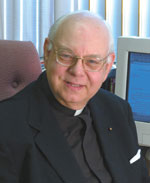Easter Sunday of the Resurrection of the Lord / Msgr. Owen F. Campion
The Sunday Readings
 The Church celebrates the Easter Vigil late in the evening on Holy Saturday. These readings are those proclaimed during Masses on Easter Sunday itself.
The Church celebrates the Easter Vigil late in the evening on Holy Saturday. These readings are those proclaimed during Masses on Easter Sunday itself.
For its first reading on this extraordinary feast of Christian faith, the Church presents us with a passage from the Acts of the Apostles. Acts is, in effect, a continuation of
St. Luke’s Gospel, with scholars suggesting that this Gospel and Acts were the work of the same author. Beginning with Christ’s ascension, Acts reports the life of the infant Church in Jerusalem and the initial spread of Christianity.
Important in the early chapters of Acts is a series of sermons delivered by St. Peter. He always spoke for the Church and especially for the surviving Apostles. In the sermon heard in this reading, Peter briefly gives a synopsis of the life of Jesus. Sent by God, Jesus was crucified, the victim of human scheming. He rose after death and commissioned the Apostles to continue the work of reconciling God and humanity. The Apostles learned from Jesus.
St. Paul’s Epistle to the Colossians, the source of the second reading, places Christ at God’s right hand. It says that Christians already “were raised” because they have taken Christ into their hearts (Col 3:1). Having given themselves to Jesus, they have died to earthly things and rejected earthly ideas. In the process, they have been drawn into the eternal life of the risen Lord.
St. John’s Gospel supplies the last reading. It goes into some detail about the Resurrection and its aftermath. The first figure mentioned in the story is Mary Magdalene. She was a beloved figure in early Christianity because she was an intense follower of Christ. Indeed, according to John’s Gospel, she stood beneath the cross of Calvary, refusing to abandon the dying Lord.
It was risky. She might have been construed to be an accomplice in treason against the Roman Empire. Yet she remained, despite the danger and the unforgiving Romans.
She went to Christ’s tomb before daybreak. Finding it empty, she hurried to Peter and the disciple whom Jesus loved. (Tradition long has assumed this disciple to be John, although this disciple is never identified by name in this Gospel.)
Peter and the disciple then rushed to the tomb themselves. It was overwhelming for them. Love and faith made the process easier. When the beloved disciple saw that the tomb was empty, he believed that Jesus had risen.
Reflection
It is said that, despite all the horrors of the Russian invasion of Ukraine that began in 2022, many Ukrainians still pause to observe Easter. A Ukrainian Easter tradition, centuries old, is the decoration of Easter eggs. The magnificence of their decorations puts American Easter eggs to shame.
Ukrainian eggs are not just colored, but they are festooned with the most intricate, artistic designs because, for them, an Easter egg symbolizes the tomb of Christ.
The tomb in which reposed the body of the crucified Lord was the most special of all tombs, hence the elaborate decoration.
From the tomb, on Easter morning, in the most stunning event of human history, Jesus emerged, alive once again. His grace lived. His merciful forgiveness lived. Salvation lived. People could have hope.
People today, in Christ, can have hope, confident of finding, really and truly, the way to peace in their lives, to eternal life, and to justice and peace in communities all around the world.
All of us should share the excitement of Mary Magdalene and of the Apostles when they realized on the morning of the first Easter that the Lord lives!
Aware of this thrilling fact, the first Christians totally committed themselves to Christ, listening to Peter, doing the work of the Lord. †
 The Church celebrates the Easter Vigil late in the evening on Holy Saturday. These readings are those proclaimed during Masses on Easter Sunday itself.
The Church celebrates the Easter Vigil late in the evening on Holy Saturday. These readings are those proclaimed during Masses on Easter Sunday itself.